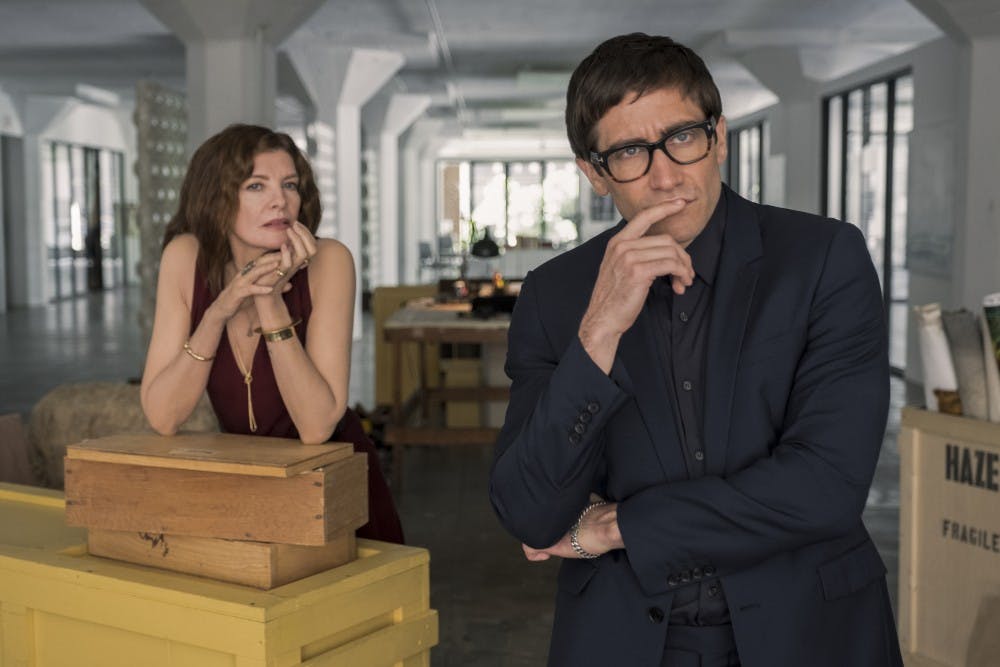Following Outlaw King, Roma, and Black Mirror: Bandersnatch, Netflix keeps its output of original productions rolling in 2019 with Velvet Buzzsaw, a satirical thriller–turned–comedy following several art world big–shots who begin commercializing a dead man’s artwork. When business begins picking up, supernatural tragedy befalls everyone who’s been involved with profiting off the dead artist, Vetril Dease.
Velvet Buzzsaw sets out to mock. From Morf (Jake Gyllenhaal), an overly pretentious art critic who does a lot of Pilates and Peloton, to art gallery owner Rhodora’s (Rene Russo) death–by–buzzsaw tattoo coming to life, Velvet Buzzsaw manages to poke fun at everything it aims to stand for. The art world is ridiculed as a JUULing, champagne–filled bubble of shallow, money–seeking adults who would kill to spike on Instagram, and the supernatural thriller genre is warped into an absurd chronology of disjointed and silly deaths. The result is a caricature of gag–worthy pomp and violence.
As far as Netflix originals go, Velvet Buzzsaw is stacked with talent. Gyllenhaal and Russo return to work with Dan Gilroy after 2014’s Nightcrawler, Toni Collette emerges in Velvet Buzzsaw after earning praise in Hereditary, and John Malkovich makes fleeting appearances in the movie. While the “art connoisseur” performances given in Velvet Buzzsaw are exaggerated enough to have had my eyes rolling, Gyllenhaal’s Morf stands out. As the movie’s token critic, Morf is quick with his words and carries himself proudly with a massive ego. Morf represents the rich and judgmental: individuals who perceive themselves so far above everybody else, in impact and importance, that nothing brought in front of them is ever good enough–even though they never do anything themselves. Gyllenhaal plays Morf with such amusing stone–faced seriousness that—even if for nothing else–makes Velvet Buzzsaw worth watching.

The other characters all also represent similar pitfalls of the art world–Josephina (Zawe Ashton) as young vanity, Jon (Tom Sturridge) as superficial greed, and Piers (John Malkovich) as an alcoholic, burnt–out artist who’s had his passion sucked out of him. While each character has their own comical moments (Jon stoops down to admire piles of garbage, which he thinks is art), they aren't amusing enough. Josephina’s high–brow snobbery, coupled with Velvet Buzzsaw’s two–hour run time, warrants more than just an eye roll after a few laughs—by the end of Velvet Buzzsaw I resorted to finger–tapping and the occasional glance at my phone to keep from mentally checking out and abandoning the movie entirely. They’re just boring. That’s it. Character growth is given no place in Velvet Buzzsaw, which is appropriate given its premise, but ends up presenting the viewer with two hours of repeat pretentious character showcases.
Given all the characters’ horribly frustrating presences in Velvet Buzzsaw, their eventual demise at the hand of what they both idolize and trample on most—art—should be satisfying. Yet again, Velvet Buzzsaw’s lengthy run time and slow pacing ruin what could’ve been the movie’s saving grace. Spoiler alert: Jon is killed an hour into the movie, Gretchen (Toni Collette) thirteen minutes later, and Morf, Josephina, and Rhodora another thirty minutes later. For a movie that so obviously sets up its characters for the ultimate demise (and releases a trailer that reveals nearly all of the movie's deaths), the long periods between action act as padding, meant to increase tension for an explosive, triple–kill finale, but end up as drawn–out sequences that add little to the movie. We get it, everyone’s scared to die. And they're all doing very little to prevent it from happening.
Although a JUULing Gyllenhaal and on–screen AirPods are aggravatingly funny and the movie lives up to its nonsensical title and premise, Velvet Buzzsaw is no masterpiece. It’s worth a watch with your friends for relevancy’s sake, but not if you’re looking for something grippingly scary or thought–provoking.







